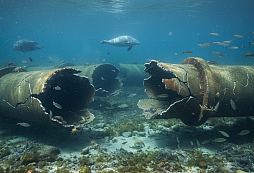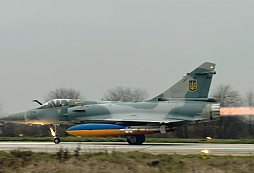Water as a strategic weapon: New conflicts in a changing climate
Control over water resources is becoming a new form of geopolitical power. From Chinese dams on the Mekong River to the Israeli-Palestinian dispute over the Jordan River to Europe’s drying rivers, water scarcity is rewriting the rules of international security. For the Czech Republic, which lies on the European watershed without significant tributaries, this transformation poses a potential existential challenge.

Current water conflicts represent a fundamental change in the nature of international security. According to UNESCO's March 2024 report, "UN World Water Development Report," only 32 of the 153 countries sharing transboundary waters have at least 90 percent of their transboundary river basins covered by a functioning water cooperation arrangement. Meanwhile, water-related security incidents have increased dramatically—the American company Seerist recorded a total of 412 water-related incidents by May 20, 2024, compared to 273 for the whole of 2019.
Another American institution, the Pacific Institute, which maintains the most comprehensive database of water conflicts, documents a disturbing trend. The period 2012–2021 saw approximately four times more conflicts over water resources than the years 2000–2011. In 2023, violent incidents increased by 50 percent compared to 2022, while 2022 saw almost twice as many conflicts as the previous year.
Three factors are driving this crisis. The first is technological inequality—some states control waterways with massive dams, while others are at their mercy. The second is the transformation of water from a public good to a strategic commodity. The third, most critical, is climate change, which is altering millennia-old patterns of rainfall and river flow.
The Czech Republic is entering this era from a vulnerable position. It lies on the main European watershed of three seas and is almost entirely dependent on rainfall. According to data from the Czech Meteorological Institute, the country has an average of around 700 millimeters of rainfall per year. Climate data shows that average annual rainfall in the Czech Republic in 2018 was only 522 mm, which was just 76 percent of the average for 1981 to 2010.
Mekong: China holds the taps
China's strategy on the Mekong River shows how water is becoming a tool of geopolitical dominance. Eleven giant Chinese dams on the upper reaches of the river give Beijing control over water for 60 million people in Thailand, Laos, Cambodia, and Vietnam.
Eyes on Earth satellite data reveal a disturbing pattern. During the severe drought in the lower Mekong basin in 2019, Chinese dams restricted almost all flow from the upper Mekong during the rainy season. Typhoons and rainfall were normal to high in most of the Chinese part of the basin throughout 2019.
From April to September 2019, the Chinese part of the upper Mekong received unusually high amounts of rainfall, yet its dams blocked or restricted more water than ever before—while countries downstream suffered unprecedented drought.
While the PRC filled its reservoirs, countries further downstream faced the worst water crisis in their history. At one point, the river was approximately 5 meters lower than it should be under natural conditions. Fishermen on Tonle Sap, Southeast Asia's largest lake, lost their catches. Vietnam's Mekong Delta, which feeds millions of people with rice, faced an invasion of salt water from the sea.
Jordan: Water as a tool of occupation
The conflict over the Jordan River shows how control over water perpetuates inequality and discrimination. Israel controls the upper reaches of the Jordan River and most of the underground sources. Palestinians cannot drill wells without Israeli permission—a permission they almost never receive.
However, the numbers speak for themselves: the average Israeli consumes 300 liters of water per day, while a Palestinian consumes only 73 liters – well below the minimum of 100 liters recommended by the World Health Organization. In Gaza, the situation is catastrophic – 97 percent of the water does not meet health standards due to overpumping and contamination.
The 1994 peace treaty between Israel and Jordan allocated water from the Sea of Galilee to Jordan, but completely ignored Palestinian rights. The war in Gaza paralyzed a promising project to exchange desalinated water for solar energy, which could have been a model for regional cooperation.
European rivers: The end of certainty
The crisis facing European rivers warns that even advanced economies are not immune to water stress. The Rhine, which transports 200 million tons of cargo annually, faces unprecedented challenges. When the river's water level dropped in 2018, German industrial production fell by 1.5 percent and GDP by 0.4 percent.
The Danube reached its lowest level ever in 2024. In Novi Sad, Serbia, people crossed the river on foot—something even the oldest residents cannot remember ever happening. Wrecks of German warships from World War II emerged from the bottom, some still carrying ammunition.
German industry, historically located along rivers for cheap transport, faces an existential threat. Chemical plants, steel mills, and cement factories cannot function effectively without reliable river transport. Paradoxically, while summers bring droughts that paralyze transport, winters bring extreme precipitation and devastating floods.
Forecast: Problems on the horizon
Climate models paint a worrying picture of the future. By 2040, nearly 1 in 4 children worldwide could be living in areas with very limited water, increasing the risk of disease, water poverty, and conflict.
Some regions are expected to see a 6% decline in GDP by 2050 due to reduced availability or quality of fresh water, which could contribute to a significant increase in cross-border migration. The World Bank warns of dramatic economic impacts.
For the Czech Republic, this poses a twofold threat. The direct threat is its own water deficit—energy production will also be affected, as hot or polluted water cannot be used to generate electricity. The indirect threat, which may be even more serious, is waves of migration from regions affected by the water crisis.
The Czech dilemma
The Czech Republic faces specific challenges. Climate change and rainfall distribution, as well as water management practices, will increase water runoff from the landscape. Water will not flow into streams when it does not rain, and water levels will decrease.
Fuel is burned in reactors, water is heated, and steam turns turbines that generate electricity. This is especially true for coal, gas, biomass, and nuclear power plants; essentially, all electricity generation in the Czech Republic is at risk without sufficient water.
The energy sector, the backbone of the Czech economy, is extremely vulnerable. A decline in flow rates could cause a significant loss of production capacity, which would have dramatic economic and social consequences.
Conclusion
Water conflicts represent a turning point where the future architecture of world power will be decided. Control over water is becoming as important as control over territory or oil once was. The Czech Republic must act in three directions. The first is technological revolution—investment in water retention in the landscape, smart irrigation, and industrial water recycling. The second is energy transformation – the transition to solar and wind energy is not an environmental luxury, but a security necessity. The third is regional cooperation – a coordinated response to the crisis with partner countries.
NATO and the EU must develop a water security doctrine. Attacks on water infrastructure should be considered an attack requiring a coordinated response. History shows that civilizations that failed to adapt their relationship to water have disappeared. Today's globalized civilization cannot afford local collapse – the fall of one region will drag down the others. For the Czech Republic, it is not a question of whether it will get involved. The question is whether it will stand at the dawn of a new era of water security as an architect or as a victim.























